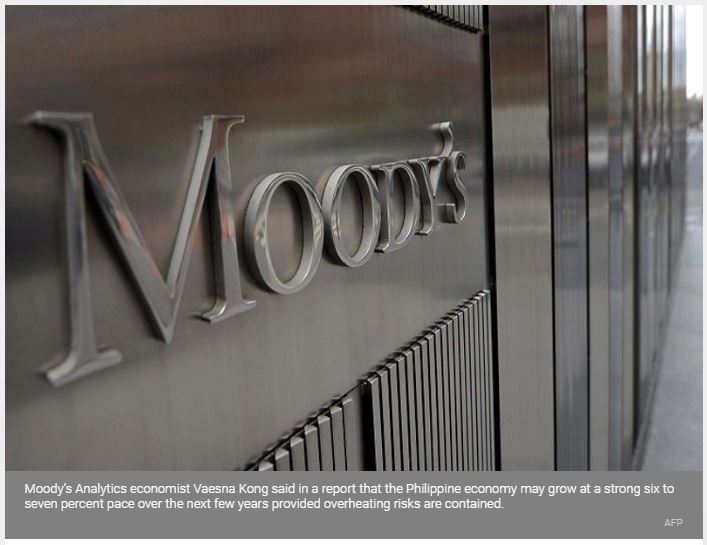Moody’s Analytics sees strong Philippines GDP growth
MANILA, Philippines — The Philippines is poised to book a strong gross domestic product (GDP) growth of between six and seven percent over the next few years despite the slowdown in the past few quarters, according to Moody’s Analytics, a unit of Moody’s Corp.
Moody’s Analytics economist Vaesna Kong said in a report that the Philippine economy may grow at a strong six to seven percent pace over the next few years provided overheating risks are contained.
“Notwithstanding this period of slower growth, which we expect to persist in the near term as imports remain strong and the combination of higher inflation, taxes and interest rates undermines consumer spending, we expect the Philippines to remain a standout growth performer in coming years,” Kong said.
The country’s GDP growth eased to its slowest pace in three years at 6.1 percent in the third quarter from 6.2 percent in the second quarter and 6.6 percent in the first quarter due primarily to the drag in exports as well as weakening private consumption.
Economic managers through the Development Budget Coordination Committee (DBCC) have lowered the GDP growth target this year to a range of 6.5 to 6.9 percent but retained next year’s growth forecast at seven to eight percent.
He said the Philippine economy still benefits from one of the youngest populations in the region as well as steady inflows of overseas worker remittances and a strong business outsourcing processing industry.
Furthermore, Kong said investment is also poised to remain strong due to the ramp-up in infrastructure development under the Duterte administration’s Build Build Build program.
“The relatively soft GDP reading was not all that surprising. Imports are surging on the back of President Rodrigo Duterte’s large infrastructure development program, which is driving up demand for imported capital goods,” Kong said.
The economist said growth in the Philippines has long been undermined by poor infrastructure, as chronic congestion and logistics issues limit the country’s productive capacity.
The Duterte administration aims to raise infrastructure spending to 7.4 percent of GDP by 2022 from less than three percent under prior administrations.
“But while the big increase in infrastructure development should leave the Philippines in a good position to take advantage of its favorable demographics, it is also putting pressure on the current account balance,” he said.
He explained the current account shortfall widened to 1.9 percent of GDP in the first half of the year from 0.7 percent of GDP in 2017 as the peso emerged as one of the worst performing currencies in the region, depreciating by 5.5 percent.
“Although a weaker peso may be helping to prop up exports, it is also making imports more expensive and is contributing to a significant pickup in price pressures,” Kong said.
Inflation stood at a near-decade high of 6.7 percent in October, bringing the average to 5.1 percent in the first 10 months, exceeding the BSP’s two to four percent target.
The BSP’s Monetary Board raised this year’s forecast to 5.3 percent instead of 5.2 percent after taking into account the fare and wage hikes but lowered next year’s forecast to 3.5 instead of 4.3 percent due to the passage of the rice tarrification bills by the both houses of Congress as well as other non-monetary measures.
Source: https://www.philstar.com/business/2018/11/19/1869712/moodys-analytics-sees-strong-philippines-gdp-growth#qr7smoU4FDo23sSv.99


 English
English




